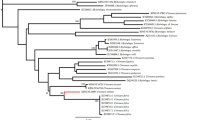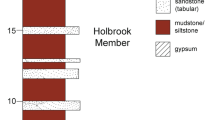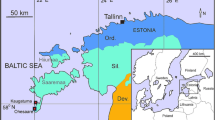Abstract
The modern principles of marine biostratigraphy ask for more exact fossil determinations. In view of the increased activity in nearly all countries concerning this modern trend in geology more uniformity in the methods used for the determination of fossils and especially of microfossils, is needed.
In this way a better understanding of the stratigraphical range of important species and their natural relations to other species in all parts of the world would be obtained. For this purpose the study of the internal structures is also important: siphuncular structures of the ammonite shell—heterostrophical oldest volutions of gastropods—canal systems of foraminifers. A few examples are given and figured.
A few remarks on biostratigraphy, paleo-ecology, facies and guide fossils serve as an introduction.
Similar content being viewed by others
References
Allan, Robin Sutcliffe, (1948), — Geological correlation and paleoecology, — Bull. Geol. Soc. America, Vol.59, pp. 1–10.
Knight, J. B., (1947), — Paleontologist or geologist — ibid., Vol.58, pp. 281–286.
Lowman, S. W., (1949), — Sedimentary facies in Gulf Coast, — Bull. Amer. Assoc. Petrol. Geol. Vol.33, No. 12, pp. 1939–1997.
Weller, J. Marvin, (1947), — Relations of the invertebrate paleontologist to geology, — Journ. of Pal., Vol.21, No. 6, pp. 570–575.
Moore, Raymond C. (1948), — Stratigraphical paleontology, — Bull. Geol. Soc. America, Vol.59, pp. 301–326.
Schindewolf, O. H., (1950) — Grundfragen der Paläontologie, — E. Schweizerbart’sche Verlagsbuchhandlung, Stuttgart.
Walther, J., (1919), — Allgemeine Paläontologie, — Berlin.
Ammonites
Arthaber, G. van, (1926), —Ammonoidea leiostraca aus der oberen Trias von Timor, — Jaarb. Mijnw. in Ned. Indië, Verh. II en Atlas.
Böhmers, J. C. A., (1936), — Bau und Struktur von Schale und Sipho bei permischen Ammonoidea, — Dissert. Univ. Amsterdam, 128 pp.
Branco, W., (1879–1880), — Beiträge zur Entwicklungsgeschichte der fossilen Cephalopoden, I — Paleontographica,26, 17–50, ibid. Paleontographica,27, 1–70.
Diener, C., (1920), —Ammonoidea trachyostraca aus der mittleren und oberen Trias von Timor, — Jaarb. Mijnw. in Ned. Indië, Verh. 4e Ged. en Atlas.
Grandjean, F., (1911), — Le Siphon des Ammonites et des Bélemnites, — Bull. Soc. géol. France (4), x (1910), 496–519.
Hyatt, A., andSmith, J. P., (1905), — Triassic Cephalopod Genera of America, U.S., — Geol. Survey, Prof. Pap., No.40.
Miller, K. A., andUnklesbay, A. G., (1943), — The Siphuncle of late Palaeozoic Ammonoids, — Journ. Pal.,17, 1–25.
Spath, L. F., (1933), — The Evolution of the Cephalopoda, — Biol. Reviews,8, 418–462.
— (1936), — The Phylogeny of the Cephalopoda, — Pal. Zeitschr.,18, 156–181.
— (1950), — The study of Ammonites in thin, median Sections, — Geol. Mag., Vol.87, No. 2, pp. 77–84.
Voorthuysen, J. H. van, (1940), — Beitrag zur Kenntnis des innern Baus von Schale und Sipho bei triadischen Ammoniten, — Dissert., Univ. Amsterdam, 143 pp.
Welter, O. (1914), — Die obertriadischen Ammoniten und Nautiliden von Timor, — InJ. Wanner, Pal. von Timor, I. Lief. Stuttgart.
Gastropods
Dall, W. H., (1924), — On the value of nuclear character in the classification of marine gastropods, — Journ. Wash. Akad. Sci., Vol.14, pp. 177–180.
Finlay, H. J., (1931), — On Austrosassia, Austroharpa and Austrolithes, new genera; with some remarks on the gastropod protoconch, — Trans. Prod. N.Z. Inst., 62, pp. 7–19.
Kesteven, H. L., (1912), — The constitution of the gastropod protoconch; its value as a taxonomic feature and the significance of some of its forms, — Proc. Linn. Soc. N.S.W., Vol. XXXVII, pp. 49–82.
Marks, Jay Glenn (1949), — Nomenclatural units and tropical American Miocene species of the gastropod FamilyCancellariidae, — Journ. of Pal., Vol.23, No. 5.
Voorthuysen, J. H. van, (1945), — Enige opmerkingen over de bouw van de Protoconch der gastropodenschaal in verband met de waarde hiervan voor de phylogenie, — Verh. Geol. Mijnb. k. Gen. v. Nederl. en Koloniën, Geol. Serie Deel 14.
Walther, H., (1951), — Jurassische Mikrofossilien, insbesondere Gastropoden, am Südrand des Hils, — Diese Z.25, pp. 35–106.
Wicher, C. A., undHoffmann, K., (1942), — Der grobe Aufbereitungsrückstand, ein wertvolles Bindeglied auf dem Wege zur Biostratigraphie, — Öl und Kohle38, 821.
Foraminifera
Bettenstaedt, F., (1948), — Stratigraphy and taxonomy, — The Micropaleontologist, Vol.2, No. 4, Oct.
Brotzen, F., (1942), — Die ForaminiferengattungGavelinella nov. gen. und die Systematik der Rotaliiformes, — Sver. geol. Undersökn, Serie C, No. 451, Arsbok36, No. 8.
Bartenstein, Helmut, (1950), — Die Trennung von Gattungen und Arten innerhalb derLagenidae, ein Beitrag zur Problematik der Foraminiferen-Taxonomie, — Senckenbergiana, Band31, No. 5/6, pp. 339–345.
Cushman, Joseph A. (1947), — Foraminifera, their classification and economic use, — Harvard Univ. Press, Cambridge, Massachusetts.
Dufour, J., (1943), — Enige opmerkingen uit de praktijk van een micropaleontoloog, — Geologie en Mijnbouw, 5e jaarg. N. S. No. 9–10, Sept.–Oct.
Goudkoff, Paul P. (1948), — Stratigraphic approach in Micropaleontological study, — The Micropaleontologist, Vol.2, No. 1, Jan.
Glaessner, Martin F., (1945), — Principles of Micropaleontology, — Melbourne Univ. Press.
Hecht, F. E., (1948), — The revision of taxonomy, — The Micropaleontologist, Vol.2, No. 4, Oct.
Hiltermann, H., (1949), — Die wichtigsten Ergebnisse der Mikropaläontologischen Arbeiten von Nordwestdeutschland, — Erdöl und Tektonik in Nordwestdeutschland, Amt für Bodenforschung, Hannover-Celle, pp. 326–334.
Hofker, J., (1950), — Wonderful animals of the sea: Foraminifera, — The Amsterdam Naturalist, Vol.1, No. 3, pp. 1–20.
Höglund, Hans, (1947), — Foraminifera in the Gullmar Fjord and the Skagerrak, — Zool. Bidrag from Uppsala, Band26.
Natland, Manley L., (1933), — The temperature- and depth-distribution of some recent and fossil Foraminifera in the southern California Region, — Bull. Scripps. Inst. Ocean. Univ. Calif. Techn. Ser., Vol.3, No. 10, pp. 225–230.
Norton, Richard D., (1930), — Ecologic relation of some foraminifera, — California Univ., Scripps Inst. Oceanogr., Bull., Techn. Ser., Vol.2, pp. 331–388.
Ovey, C. D., (1948), — Some ecological aspects of the Foraminifera and their application to stratigraphy, — S. E. Naturalist and Antiquary.
Parker, F. L., (1948), — Foraminifera of the continental shelf from the Gulf of Maine to Maryland, — Bull. Mus. Comparative Zoöl. Harvard Coll., Vol.100, No. 2.
Phleger, F. B., (1942), — Foraminifera of submarine cores from the Continental slope, — Part. 2, Bull. Geol. Soc. Am., Vol.53, No. 7, pp. 1073–1098.
Said, Rusdhi, (1950) — The distribution of Foraminifera in the northern Red Sea, — Contr. Cushman Found. For. Res., Vol.1, Parts 1 and 2, pp. 9–29.
Voorthuysen, J. H. van, (1948), — Some remarks on the urgency to build up a more natural classification of the Foraminifera, — The Micropaleontologist, Vol.2, No. 3, July.
— (1950), — Recent indigenous and Upper-Cretaceous derived Foraminifera from the Netherlands tidal flats (Wadden), — Tijdschr. Nederl. Aardr. k. Gen., Deel.67, Afl. 3, pp. 89–93.
Wicher, C. A., undHoffmann, K. (1942), — Der grobe Aufbereitungsrückstand, ein wertvolles Bindeglied auf dem Wege zur Biostratigraphie, — Öl und Kohle38, pp. 821–824.
Wicher, C. A., (1949), — On the age of the higher Upper Cretaceous of the Tampico embayment area in Mexico, as an example of the worldwide existence of microfossils and the practical consequences arising from this, — Bull. Mus. d’Hist. Nat. Pays Serbe, Serie A-2, pp. 76–105.
Wiseman, J. D. H., andOvey, C. D., (1950), — Recent investigations on the deep-sea floor, — Proc. Geol. Assoc., Vol.61, Part 1, pp. 28–84.
Author information
Authors and Affiliations
Additional information
With 12 figures in the text
Rights and permissions
About this article
Cite this article
van Voorthuysen, J.H. Remarks on the internal structure of the shells of Ammonoidea, Gastropoda and Foraminifera — with a short introduction on biostratigraphy and paleo-ecology. Paläont. Z. 26, 30–48 (1952). https://doi.org/10.1007/BF03041727
Issue Date:
DOI: https://doi.org/10.1007/BF03041727




